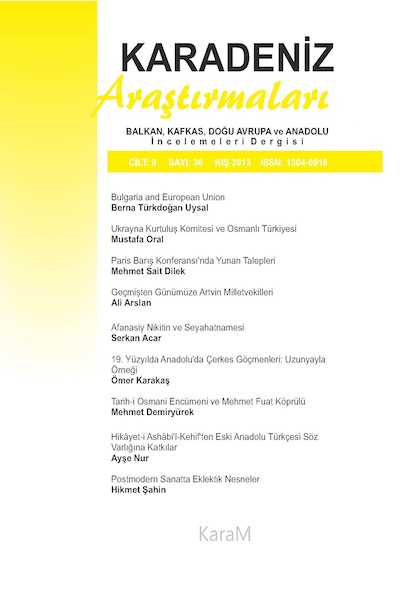Karay Türkçesinin Kendisine Has Özellikleri ve Türk Lehçeleri Arasındaki Yeri
The Distinctive Characteristics of Karaim and Its Place among Turkic Dialects
Author(s): Selma GülsevinSubject(s): Language and Literature Studies
Published by: Karadeniz Araştırmaları Merkezi
Keywords: Karaim; Kipchak; Oghuz
Summary/Abstract: Karaim is one of the Turkic dialects that face extinction. Karaim, which has so few speakers today, is not a language used for daily needs anymore. Karays have led isolated life styles due in part to their religion and been able to protect the characteristics of their language. Karaim, a Kipchak dialect, has three accents and the literary language is based on Troki accent. Karaim attracts so much attention in terms of its “own characteristics”, “archaic characteristics” as well as “parallelisms with Oghuz” besides Kipchak features. Some of its odd features can be summarized as follow: One of its own characteristics, perhaps the most crucial, is seen in its syntax. In Karaim, which has inverted syntax commonly, inversion in word groups is also quite common. While it is a common rule for Turkic languages that nouns in adjective clauses with numbers are not added a plural suffix, this suffix could be used in Karaim. It has special structures like “pronoun +es” and “pronoun +de” which make indefinite pronouns. Some Old Turkic elements have been protected in Karaim such as ıy- ‘to send’,yer-sub ‘country, homeland’, kol- ‘to want’. Besides, some noun clauses that were made in the form of adjective clauses (Türk bodun ‘Türk milleti’) have the same structure in Karaim as well (koyanlar ulus ‘tavşan halkı, tavşanlar’). Though it is a Kipchak language, Karaim has some parallelisms with Oghuz. For some words Oghuz words are used instead of Kipchak words (Kipchak: tüşün- / Oghuz: aŋla-; Karaim: anla-). That first person singular pronoun is inflected with -m (menim) and that ‘b’ sound in ‘bu’ pronoun is not converted into ‘m’ while inflected with case suffixes (bunça, bunda) are two of these parallelisms.
Journal: Karadeniz Araştırmaları
- Issue Year: 2013
- Issue No: 36
- Page Range: 207-222
- Page Count: 16
- Language: Turkish

